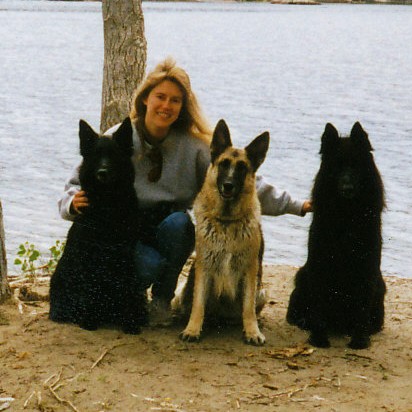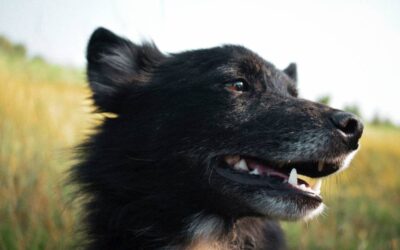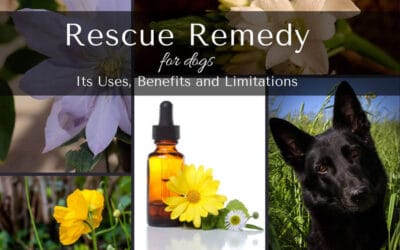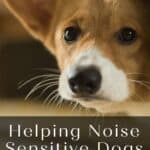Fear of thunder, fireworks and gunshots is a common behavior complaint in dogs, but there is no “one size fits all” solution for solving it. Many dogs will respond well to a single natural calming remedy, but many will require either additional aids or a different approach altogether. This article discusses a variety of natural, holistic therapies for noise sensitive and noise phobic dogs.
I often get asked about how best to help noise sensitive dogs during storm, hunting, and fireworks seasons. Everything from which flower essence formulas will be best, to ways to increase the effectiveness, other supplements, and the variety of products available that can help dogs that become anxious or panicked during noise events.
So I thought I would prepare an online resource for customers (and anyone else) with noise sensitive dogs. Hopefully you will find some useful info here.
Simple things you can do to help noise sensitive dogs
First, let’s look at some simple things that can be done to reduce the impact of noise on your dog. For some dogs, doing one or more of these can be enough. If you haven’t tried them, go ahead and see if they make a difference with your dog. If your dog is extremely sensitive and fearful of scary noises, you may need to use a combination of approaches to help him. But I would start with these first.
Provide some masking noise
I think this is one of the most helpful things you can do. Noise-generating appliances like air conditioners can help, but rarely make enough noise to mask outside sounds of any volume.
So, I prefer recorded “white noiseâ€. You can find audio recordings online of rain falling (without thunder, of course), streams running, waves crashing, wind blowing, etc. I even have one of an old time steam training running (which is generally awesome, beyond any value as white noise).
If you have a streaming device (such as Roku) that allows you to play YouTube videos on your TV or home sound system, YouTube is a great source of free white noise. Just play the video on high-ish volume wherever your dog is likely to be in the house. I’ve found this does a pretty darned good job for all but the loudest outside noise.
Here are some of my favorite white noise videos on YouTube:
- Soft, continual rain
- Rain sounds with a black screen (great at night for sleeping)
- Calming white noise specifically for dogs (good for general noise, not necessarily for loud booms)
- Stream sounds in an autumn wood
Block any visuals that accompany noise
If noises are accompanied by flashes, by all means close up the curtains! The less your dog can connect with the scary noises, the better. So, pull down the blinds and close the curtains (drape a blanket over windows if necessary) to keep any light flashes outdoors.
Provide a safe space
This one really depends on the dog. For some dogs, the only safe space is in your lap or at your feet. But for others, a sheltered bathroom, or even the bathtub, is considered a safer spot during storms and fireworks. For some dogs, a secure crate, covered to with a light cloth, can be a good safe place. Closets work for other dogs.
I had a neighbor once whose Golden Retriever was terrified of thunderstorms, but would settle down peacefully if allowed in the (canopied) back of his dad’s truck. For him, that was a “happy placeâ€, even during storms.

Try a pressure wrap
Most people have heard of the Thundershirt by now for noise phobic dogs. And if you have access to one, by all means give it a try; it can help in many cases.
But you can also use the same principle of applying the simulated pressure of a “body hug†with an old t-shirt wrapped snug on the dog, or by using Ace bandages to make an “anxiety wrapâ€. (Here’s an article that shows you how to make your own anxiety wrap, either with ace bandages or an old t-shirt.)
[Hopefully it’s obvious that these types of wraps should only be used when the dog is closely supervised, and after the dog has had a proper introduction to them. Also check frequently to make sure there are no areas of constriction that could hamper your dog’s circulation.]
Get hands on
Not every dog will want to be touched when anxious from frightening noises. However, if your dog welcomes a comforting touch, then massage, TTouch, or acupressure can be helpful to bring about a calmer, less anxious state. While each takes a little practice and getting the dog familiar, none require any expertise or special equipment.
So, if you think your dog might benefit from some hands-on during the next storm, take some time now to learn a technique and create a positive association.
Bach Rescue Remedy blends for fear of thunder, fireworks, gun shots in dogs
Aldaron Essences’ online store closed permanently on May 31, 2023. I no longer sell flower essence formulas directly to customers.
Instead, I’m focusing on developing the Aldaron Essences blog into a premier resource on flower essences for dogs and other animals. I’ll also be expanding my dog training website, Train2Behave.com, as well as my Etsy store of mostly dog training- and breed-related apparel and gifts.
In the coming weeks, you can expect new pages on this site that will detail some of my most popular flower essence formulas for dogs. These pages will replace the old links to those products on the store. Thanks for your patience during the transition!
Best,
julie
For many dogs, Bach Rescue Remedy is, by itself, a tremendous stress reliever for noise phobic dogs. There are many, many people whose dogs get relief by using Rescue and nothing else. So that’s certainly a good first resort.
For dogs with noise phobias that do not respond well enough to Rescue Remedy by itself, it’s worth trying a combination that includes additional Bach remedies to help with emotions associated with the phobia. (For more on this, be sure to read my article on Bach Rescue Remedy, and its uses and limitations.)
Aldaron Essences’ Very Scary Things is our original Bach flower blend for fear and anxiety in dogs. It’s excellent for alleviating stress and anxiety, and increasing confidence and courage, in fearful dogs that shake and cower during scary noise events. It’s our most popular (and reviewed) formula for relieving stress and fear in noise sensitive dogs.
Aldaron Essences’ High Anxiety is a very similar blend to Very Scary Things, but High Anxiety has an additional Bach flower remedy to help tone down the high strung nature of work-minded, responsible-natured dogs. This type of dog tends to work itself up into a higher state of anxiety, and the added remedy helps take that extra edge off.
Aldaron Essences’ Poise is our Bach flower blend for dogs that get truly terrified and go into panic mode. Dogs that destroy rooms or crates trying to get out, that really go out of their mind, that lose control of bowels or bladder, etc., when freaked out by fireworks or thunder, generally can get quite a bit of relief from Poise.
If one of those formulas doesn’t seem like it covers everything your dog experiences, it’s fine to combine two or more.
I’ve also found it may be useful to give a basic confidence-supporting blend, like Aldaron Essences’ Confidence Plus, during parts of the year that don’t tend to have booms and bangs. Building up the dog’s basic level of confidence and courage over time can really help in reducing the noise sensitive dog’s reactions during “noise seasonâ€.
Finally, you can always Design Your Own blend of Bach flower remedies. Each dog is an individual and may have slightly different emotions involved with their reactions to thunder, fireworks, gun shots and other loud, sudden noises. Choosing flower to match your dog’s emotions is pretty easy to do.
On my Design Your Own formula page, you can find descriptions of each Bach flower remedy and what it helps with.
And my article, Bach Flower Remedies for Fear, Stress, and Anxiety in Dogs, will guide you through selecting Bach flower remedies specially for fearful dogs with noise sensitivities.
How to give flower remedies to help noise phobic dogs
On the spot use
Flower remedies can be very effective for relieving the effects of noise sensitivity in many dogs. Bach Rescue Remedy, for example, has gained a tremendous reputation for success used “on the spotâ€, that is, only given when the dog is in obvious distress. But — timing of the doses is important.
To use any flower remedies this way, give your dog a few drops in his mouth or on a treat, as soon as the noise starts, or as soon as you see him starting to get stressed. Alternatively, you can apply them topically or mist them around the dog to breathe in. (See my article on Simple, Effective Ways to Give Flower Remedies for more ideas.)
Repeat the same dose every few minutes until your dog visibly relaxes.
I like to space the doses about 3-10 minutes apart. Time the doses more closely together if your dog is reacting very strongly, and further apart if the reaction is moderate.
When using flower remedies for acute situations (storms, fireworks and the like), you will typically see an improvement by the time you’ve given 3 or 4 doses in succession. If you don’t see any improvement after 4 or 5 doses, it’s reasonable to assume this is not something that’s going to help your dog.
Longer term use
If your dog doesn’t respond to flower remedies when used as above, you might try “greasing the wheels†a bit. If you can start giving your dog flower remedies early in the season, this will give the essences time to begin working under the surface, so that when the noises that scare your dog begin, he’s already somewhat prepared to be calmer and braver.
Ideally, you would start out at least two weeks in advance of anticipated scary noises. Give the remedy 3 or 4 times per day, every day, during those weeks. Then, when noises do start, give as described above, for “on the spot†use. (And continue giving the formula 3-4 times per day for the whole “season†when noises are likely to happen.)
Anxiety-Relieving Herbal and Nutritional Supplements
In addition to flower essences, there are other natural options for improving your dog’s response to noise. Different dogs will respond better to one supplement or another, and many dog owners find the best results come from combining treatments.
While I recommend checking with your veterinarian about giving and combining herbal and nutritional supplements in general, it’s worth noting that flower remedies are completely safe (and remain effective) when combined with other therapies.
As you read through the supplements below, it may seem like there are a lot of choices for helping your dog with noise issues. This is true, but not every one will work with every dog. Often the key is to figure out the right combination of therapies for your individual dog. But if you take the time to experiment a little, you should be able to find a drug-free way to ease stress and anxiety.

Herbs and Nutraceuticals
There are a number of useful and safe supplements that can be given to dogs that strengthen nerves and relieve anxiety.
With any food supplement, be sure to confirm with your veterinarian that your dog doesn’t have any conditions that would prevent him taking it safely.
Melatonin
Melatonin is a very safe supplement which is available in in most grocery and drug stores. Its most common use is for insomnia, but it acts as an anti-anxiety supplement in many dogs.
Melatonin does not need to build up in the system; it can be used “on the spotâ€, although best results tend to be seen if it can be given an hour or so before booms and bangs start.
The easily-available human form is fine to use in dogs. The only very important caveat is to check the ingredient label for xylitol, which is highly toxic to dogs. Xylitol is a common sweetener in melatonin chewable lozenges.
For a great resource which gives melatonin history, types of use, and dosages for dogs, read this article on Noise-Phobic Dogs from the Whole Dog Journal.
Traditional Herbs
The same herbs that work to relax us (for instance, to fall asleep more easily) also work for dogs to relax and relieve anxiety. In general, herbs are intended for short-term, periodic use, rather than daily, ongoing use. They can be used singly, or more commonly, in blends. Herbs are available in bulk, in capsules and in tinctures (liquid form) or, of course, you can grow your own!
Three of the most common anti-anxiety herbs are:
- Chamomile [Read more.]
- Valerian [Read more.]
- Passionflower [Read more.]
To learn more about using individual herbs to address anxiety issues, especially for panicky, very stressed dogs, read Calmative Herbs for Canine Panic.
While I’m a serious do-it-yourselfer, I admit I often gravitate to pre-made blends when it comes to herbs. I look for products that have a history of successful use in dogs, and that do not contain a bunch of fillers and other ingredients I don’t want my dogs to have.
Two pre-made herbal anti-anxiety blends for dogs that I’ve recommended for awhile are:
- Nature’s Farmacy Calm Caps. This is an herbal supplement that blends Valerian, Passion Flower, Kava Kava, and Black Cohosh. Nature’s Farmacy has been around quite a long time and has a great reputation (and I personally really like their products).
Note this is not a “calming treat†in a flavored base. It’s a capsule (also available as a paste) with the herbs listed and nothing else – no fillers, flavors, allergens, or junk. So you’ll need to pop the pill down your dog’s throat, hide it in a pill pocket, or mix the capsule contents in some yummy stuff. This supplement starts working within about 30 minutes and can be given a couple hours in advance, if you anticipate problem noises.
- Stress Free Calmplex by Springtime, Inc. (Springtime makes excellent natural supplements for horses, dogs, and people.) Calmplex is a tonic blend that improves nerve health, rather than an herbal relaxant. It includes Vitamin C, panax ginseng, and desiccated beef liver (great source of B vitamins), among other healthy nerve-strengthening ingredients.
Stress Free Calmplex comes as a chewable wafer that can be fed directly or crumbled into meals. It’s meant to be used over time to strengthen nerves, not as a sedative or anxiety quick fix.
Hemp and CDB oil
Obviously CBD oil has made a big stir within the pet anxiety market lately. I honestly have never used it, and so I recommend you do your own research when it comes to CBD products.
I have, however, had some experience with the hemp supplement from Canna-Pet. I used it a few years ago on one of my older dogs who developed discomfort and associated anxiety near the end of her life. I have to say I was very pleased with the results. I know some people have had good success with this supplement for noise issues.
Homeopathic Medicine for Sound Sensitivity
Homeopathic medications are another option for helping dogs with noise phobias and sensitivities. It can be a little tricky determining which remedy is the best one for your dog, but in general:
- Phosphorus 30c can be used for noise phobias in general.
- Borax 6c can be used for thunderstorm fears.
- Aconite 30c can be used for fearfulness in general as well as during thunder or fireworks.
- Aurum Metallicum 30c can be used for fear and over-sensitivity to noise.
To find out more about homeopathic remedies for noise phobias, see the Dogs Naturally Magazine article, Nervous Dog? These 3 Remedies Can Help.
Medical considerations for noise sensitive dogs
Finally, there area couple of medical issues that should be considered for dogs with noise phobia – even if you’re able to manage their reaction with a natural approach.
Hypothyroidism can trigger or worsen noise phobias (and other behavior issues)
As dogs age, it’s not unusual for thyroid hormone output to decrease, resulting in the condition known as hypothyroidism. This is a condition that can cause both physical and behavioral changes, including noise sensitivity.
For many dogs, this happens in the early senior years, which can explain why many dogs appear to suddenly develop noise phobias “out of the blue†at around 7 years old.
While scary experiences can result in noise phobia at any age, it’s worth eliminating poor thyroid function, even if it’s only a contributing factor. If you have a mature or older dog with a noise sensitivity, consider talking to your veterinarian about having her thyroid tested.
Thyroid hormone supplementation is safe, easy to give, and inexpensive. If your dog’s noise sensitivity is related to hypothyroidism, this can be an easy “quick fix†in a world with few quick fixes!
To learn more about hypothyroidism and noise phobias in dogs, read About Canine Hypothyroidism from the UK Canine Behavior and Training Society.
Are pain issues playing a part in your dog’s noise phobia?
This one’s not necessarily intuitive, but be sure to consider pain issues as a possible contributing factor in your dog’s noise issues. If we take a moment to think about it, it makes sense.
What do we do when stressed or frightened? We tense up. Same for our dogs. And if you have some underlying pain or discomfort, from age or injury, what does tensing up do? Make it hurt worse.
If you’re a dog, you can’t reason, “oh, I need to relax because getting tense is making this pain worseâ€. All you know is that loud, odd, or sudden noises cause pain. And that makes the noises even scarier.
For more on this, read Science Daily’s article, Dogs with Noise Sensitivity Should be Routinely Assessed for Pain.
There are some obvious options if you know your dog has pain issues. You can discuss with your veterinarian some safe, gentle pain relievers as an experiment to see if they help your dog react less strongly to scary noises. If your dog’s discomfort is significant, this may be the best route to go.
But keep in mind there are quite a few natural approaches to pain relief for dogs, including over the counter supplements to improve mobility and reduce inflammation.
These can be used short term for injury or strain, or long term for conditions like arthritic changes.
- Massage is a good first choice for both temporary relief of discomfort as well as aiding in long term warding off of pain.
- Chiropractic adjustments can relieve pain and discomfort by addressing the source of pain in many dogs – misaligned skeletal parts.
- Similarly, acupuncture can be very helpful.
- Anti-Inflammatory Nutritional and Herbal Supplements. There are many natural anti-inflammatory supplements. Having lived with a very active, but very dysplastic German Shepherd years ago (who lived to 13 years old, and really only had trouble in her final year), I learned a fair amount about the various options. I’ve used Ester-C, Bromelain (a digestive enzyme which, given on an empty stomach, is a very efficient anti-inflammatory), MSM, and the herbs Yucca and Devil’s Claw as natural pain relief for my dogs. It’s worth looking into if your dog has pain issues.
Here are a few helpful articles on natural herbal pain relief options:
What Can I Give My Dog For Pain? (Honest Paws)
Natural Dog Arthritis Treatments (Whole Dog Journal)
Top 10 Herbs For Natural Pain Relief (Dogs Naturally Magazine)
- Homeopathy offers several excellent alternatives for pain relief and improved mobility. I am by no means an expert on homeopathy, but have used it very successfully with my dogs and myself in the past. I’ve used Arnica (a homeopathic medication for bruising and soreness), Hypericum (helps alleviate nerve pain), and Rhus tox (helps sore, arthritic dogs that are stiff upon rising, but get better as they move about), all to good effect.
Dogs Natural Magazine discusses their top 5 pain-relieving homeopathic remedies, and how to use them, in this article: Top 5 Remedies For Dog Joint Pain And Injury
If you’re new to homeopathy, you might consider a combination formula like T-Relief (formerly Traumeel, and Traumed before that). This is an extremely well-regarded homeopathic combination for pain, soreness, and strain due to over-work, injury, or arthritis. Made for people, it works just as well in animals. Available as a tablet or topical crème.
I was interested to find this research paper on Traumeel on the National Institutes of Health website: Traumeel – an emerging option to nonsteroidal anti-inflammatory drugs in the management of acute musculoskeletal injuries.
Conclusion
Noise phobias can be long-standing and part of a dog’s temperament, they can begin suddenly after a bad fright, or they can develop in senior dogs due to age-related conditions.
Regardless of when your dog’s noise sensitivity started and why, there are many drug-free, holistic options for helping your dog. Be ready to do some experimentation, as it may take some trial-and-error to discover which products and approaches help the most.
I hope this information proves to be a useful resource to you, in giving you direction and inspiration to help your dog become less stressed and more comfortable with life’s booms and bangs.

Julie Cantrell BSc is a professional dog trainer and canine behavior consultant who’s logged many thousands of hours training dogs and teaching owners since 1990. Flower essences have been part of her work with canine behavior since 1994. (Bio)










